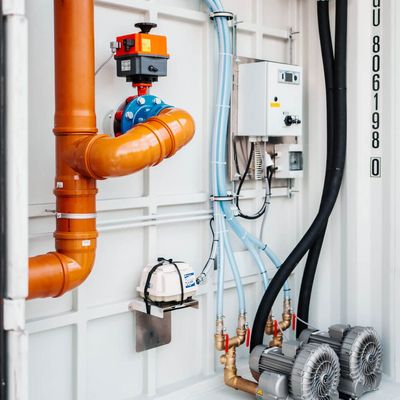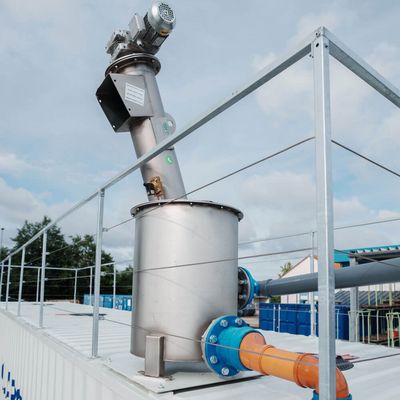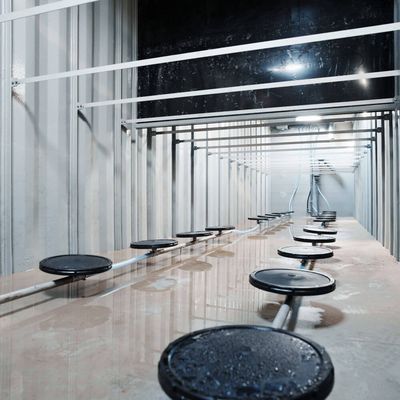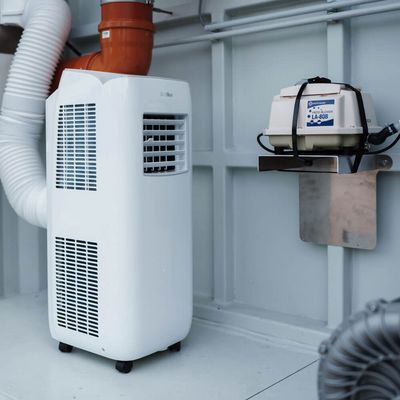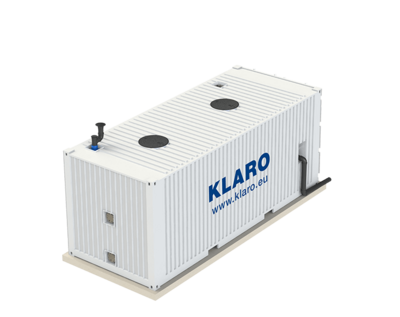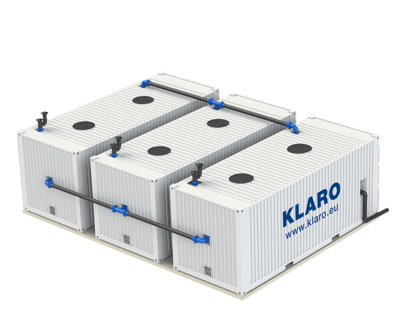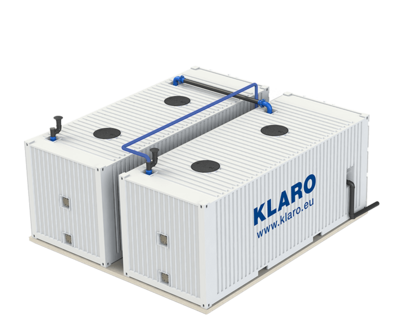KLARO Container sewage treatment plant
The mobile solution for waste water treatment
Mobile containerised wastewater treatment plants for quick application
KLARO Container is a flexible and mobile wastewater treatment system that can be used where a wastewater treatment system is necessary but there is no connection to the sewer system.
The KLARO Container wastewater treatment systems score with their quality made in Germany, flexibility and efficiency. Individually planned and produced, they are quickly set up according to the plug-and-play principle, dismantled and set up again at another location. The systems can also be installed for permanent use.
The four different variants of KLARO containerised wastewater treatment plants offer the necessary flexibility in the design of wastewater systems. They can be used for a wide range of applications:
- Refugee camp
- Military camp
- Labour and research camps
- Construction sites
- Municipalities
- Seasonal tourism/camping
- Oil and gas industry
Advantages and features

Quality
made in Germany
KLARO containerized wastewater treatment plants are all manufactured, pre-assembled and tested at our site in Bayreuth. You can rely on the top quality of all installed parts. Thanks to the high-quality workmanship, the systems can be operated in any climate zone.

Easy
to transport
The sewage treatment plant is located in one or more sea containers whose dimensions and construction meet worldwide standards. This means that the containerised sewage treatment plant can be transported on any vehicle that can also be loaded with sea containers.

Prefabricated
construction
In our factory in Bayreuth, the container sewage treatment plant is pre-assembled as far as possible, tested and prepared for transport. On site, the plant then only needs to be put into operation.

Fast assembly
and disassembly
Our container sewage treatment plants are connected according to the plug-and-play principle: The installation material such as hoses, pipes and cables are optimally matched to each other. If necessary, the system can also be quickly dismantled and set up at another location.

Simple
handling
The KLARO containerised wastewater treatment plants convince not only with their quick plug-and-play installation, but also with their simple operation. The mobile plants are designed so that staff can easily keep the system in operation and maintain it. The plant operates fully automatically and, thanks to energy-saving mode, adapts itself to the wastewater volume.

Low
costs
No planning or building is needed to operate a containerised wastewater treatment plant - the plant only needs to be placed on a solid base. This already saves costs upfront, and the plant is also highly efficient in operation: a 20 ft container needs only 13 kWh/d.

Modular
expandable
We offer four different container wastewater treatment plants to choose from:
Container.One, Container.One+, Container.Pro and Container.Xtra. All of them are modular in design and can therefore also be expanded. Basically, 10-, 20- and 40-foot containers are available. For larger wastewater volumes, several containers can be linked together, giving you the greatest possible flexibility. We have experience with containerised wastewater treatment plants up to 1,380 PE or 207 m3 of wastewater per day.

Individual
plant design
A wastewater treatment plant is only as effective and efficient as the system installed. That is why every containerised wastewater treatment plant is planned and produced to suit your exact requirements and conditions on site. In addition to a complete system in a container, containers are also available with different treatment stages, e.g. as primary treatment stages, biological stages, post-treatment stages or as sludge treatment stages.
Variants of the KLARO Container sewage treatment plant
Depending on the area of application and conditions, we offer different variants of our containerised wastewater treatment plants.
Contact us, we will be happy to advise you. You can also find more detailed information in our brochures.
Our services around your mobile sewage treatment plant
Individual modules or full service - you decide which of our diverse services you use.
Consulting
- We or our specialist partners provide comprehensive advice and plan the container sewage treatment plant to suit the individual requirements and the conditions on site.
Delivery
- Together with our partners, we ensure that the sewage treatment plant reaches its destination and is installed there.
Training
- We or our local partners will train your staff to operate the wastewater treatment plant.
Maintenance
- Our trained partners take care of the regular maintenance of the system as well as all repair work.
Example Container.One: The treatment stages
Our Container.One plant works fully biologically according to the so-called SBR process (= activated sludge plant in the impoundment process).
In contrast to models from other manufacturers, the sludge storage and buffer are already integrated in the system.
The wastewater treatment is carried out place in the following steps:
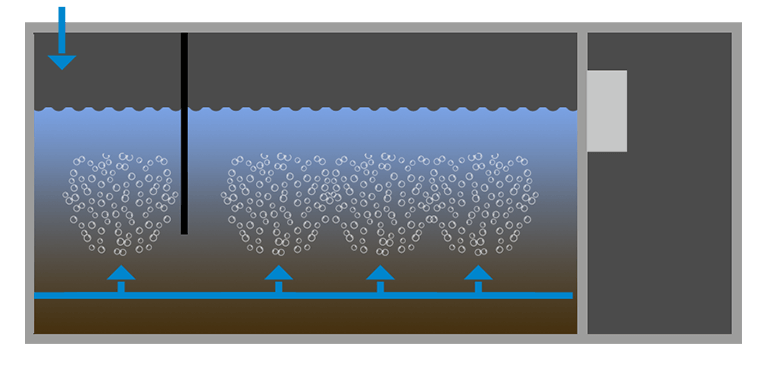
1. Aeration phase
The raw wastewater, coming from the up streamed pumping station, enters the primary zone and immediately undergoes aerobic treatment. The microorganism in the activated sludge are supplied with oxygen and thus pollutants are reduced.
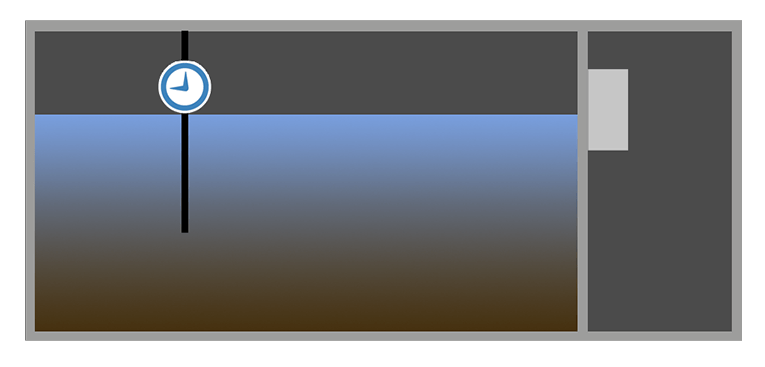
2. Sedimentation phase
When aeration is stopped, the activated sludge settles to the bottom. A clear water zone forms in the upper part of the container. If any raw wastewater enters the system, it is retained by the half baffle wall in the primary zone.
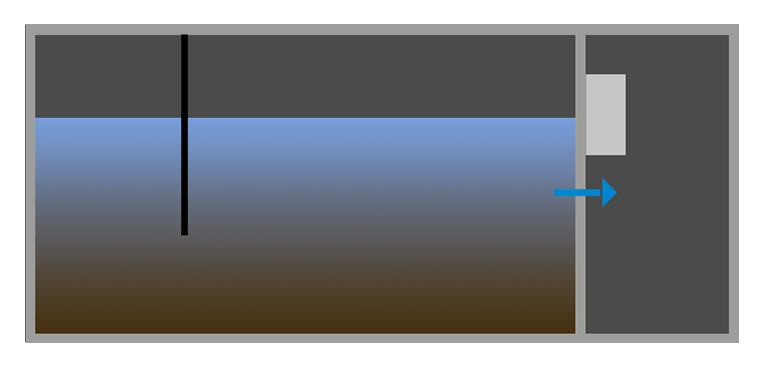
3. Clear water extraction
In the final step, the clarified wastewater is extracted by a discharge device. This discharge device is briefly backwashed to prevent any sludge from coming out.
Components of the Container.One plant
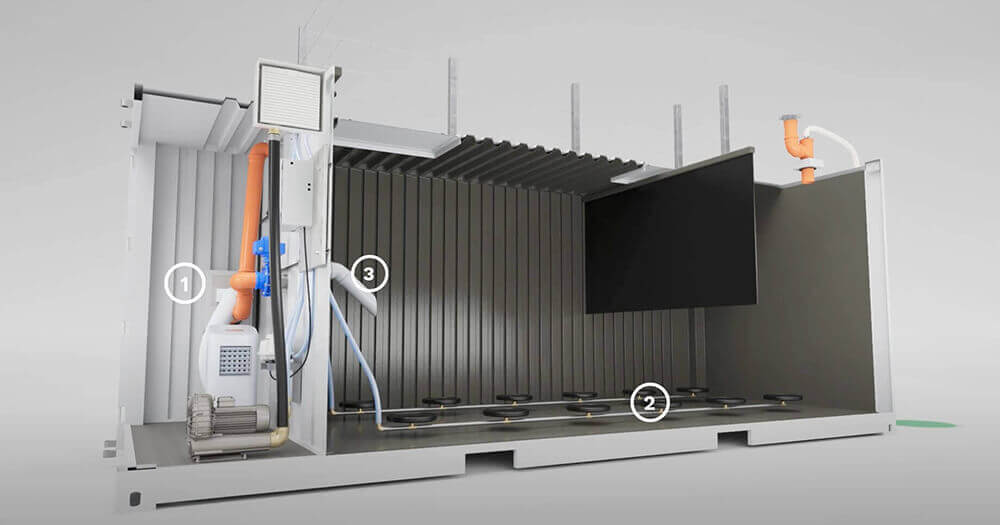
1. Machine room
The electromechanical components (e.g. control cabinet, compressor, etc.) are housed in a well air-conditioned machine room. The machine room is located at the front of every container and offers highest protection as well as best accessibility of the electrical equipment. Optionally, the KLARO WebMonitor can be added, with which remote control of the system is possible.
2. Aeration
The aeration unit of the container sewage treatment plant consists of submerged membrane aerators. These ensure optimal mixing and fine-bubble aeration of the system. They are mounted on a stainless steel pipeline.
3. Decanter
The treated water is extracted from the system via a fixed clear water discharge system (decanter). This decanter features with a butterfly valve. As soon as the flap is opened via the controller, the treated water can flow out by gravity. To prevent any sludge from being drawn of, the device is backwashed shortly before the clear water discharge.
Optional modules
Depending on requirements, KLARO containerised wastewater treatment plants can be expanded with a range of additional modules. Whether for optimising water quality, for reuse or plant control via remote control technology - we optimise the plant to your needs.
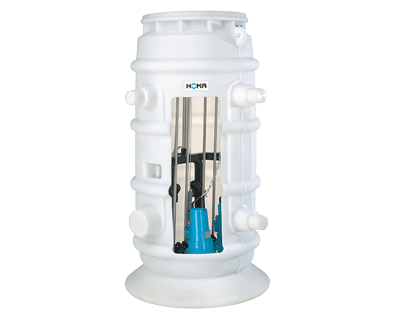
Pump station
The wastewater must be pumped into the above-ground container. For this purpose, KLARO offers optional ready-to-connect plastic shafts with wastewater cutter pumps. The buoyancy-proof plastic chamber offers flexible connection sizes.
Available as single or double pump station

Sieve screw
Optional for installation on the container roof
- Connection upstream of the container inlet - wastewater from the pump station first enters the sieve screw before flowing into the container system
- Separation of solids contained in the wastewater
- Impurities can thus be retained and do not enter the container system - increased operational safety
- Consists of a screen basket in which solids are retained and a screw conveyor that transports the solids out of the screen basket.
- Separated solids are conveyed laterally into a container
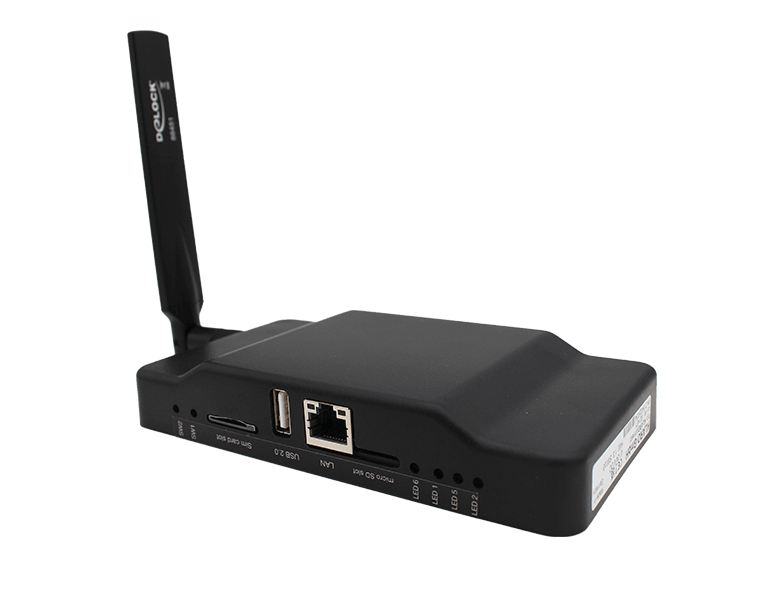
KLARO WebMonitor®
Remote monitoring, remote maintenance and remote control in the field of sewage treatment technology will become increasingly important in the future. The KLARO WebMonitor® can be used wherever maximum operational safety is required - and to relieve the operator. By means of remote diagnosis, the system can be monitored by a maintenance company. Intervention in the event of malfunctions is possible immediately.
- Cost-effective remote diagnosis in the event of a malfunction
- Higher efficiency
- Higher operational safety
- Optimised service intervals

Phosphate precipitation
The phosphate content of the wastewater can be further regulated through the use of an additional dosing pump that delivers a special precipitant into the SBR basin. This variant has also been tested and approved for use in sensitive areas.
- Complements the modular concept
- Retrofitting possible
- Long service life due to simple technology
- Maintenance-friendly
- Dosing can be easily regulated
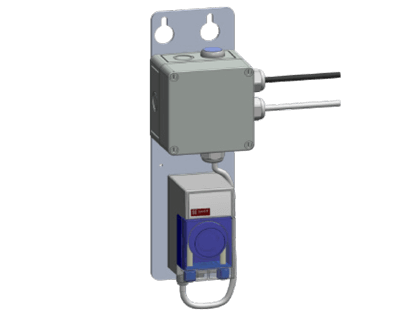
Reuse KLARO blue.cycle®
One of the biggest challenges in wastewater treatment today is finding solutions for reusing the treated water. The goal is for the water used in wastewater treatment plants to be directly reused, e.g. for garden irrigation. KLARO blue.cycle® is the result of a long and intensive development period by KLARO and stands for innovative solutions for disinfection and reuse, designed as an extension for wastewater treatment plants. The KLARO blue.cycle concept is based on a chlorination process. Chlorination is the most established method worldwide for effectively killing many pathogens present in wastewater and inhibits their regrowth through its long-term effect.
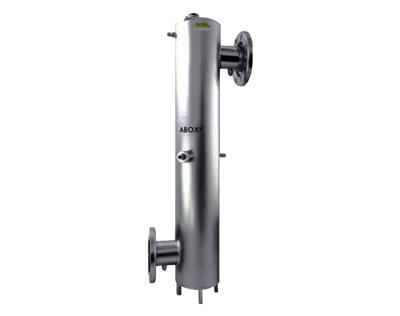
UV module
Water and environmental protection for sensitive areas with the highest requirements. During clear water extraction, the treated wastewater is subsequently irradiated intensively with UV light. This inactivates the remaining bacteria and eliminates pathogenic germs.
- Easy to retrofit
- No environmental pollution
- Simple handling
- Low operating costs
- Integrated into the machine room
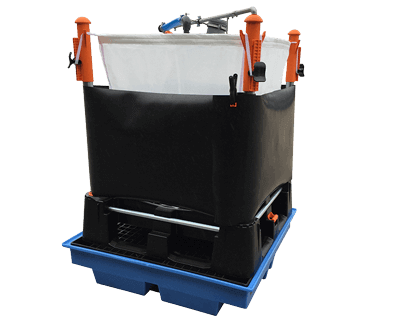
Sludge dewatering
During wastewater treatment in the containerised wastewater treatment plant, excess sludge is formed that has to be removed and disposed of regularly. With the KLARO module, the sludge is dewatered and dried on site. Volume and mass are reduced by up to 95%. This also reduces disposal costs and makes transport easier, even from remote locations. The sludge dewatering unit consists of two parts: The pump unit is used to draw off the excess sludge, e.g. during regular maintenance. A flocculant is automatically dosed and added to the sludge. The filter unit dewaters the sludge and serves to dry it - it is kept covered and ventilated in the filter unit during the drying process.
What is a container sewage treatment plant?
A container wastewater treatment plant is a wastewater treatment system that is fully integrated into a container. For uncomplicated and fast transport, we use 10-, 20- and 40-foot shipping containers in accordance with the international ISO standard for our KLARO container plants. Containerised wastewater treatment plants are used primarily for short-term use in remote areas that are not connected to a sewer system, in camps and on construction sites.
However, thanks to their high-quality workmanship and equipment, the mobile containerised wastewater treatment plants are also suitable for permanent use, for example in places that are difficult to reach and where no other connection to the sewerage system is provided. For more information, also on the mode of operation and technical equipment, please download our brochure.
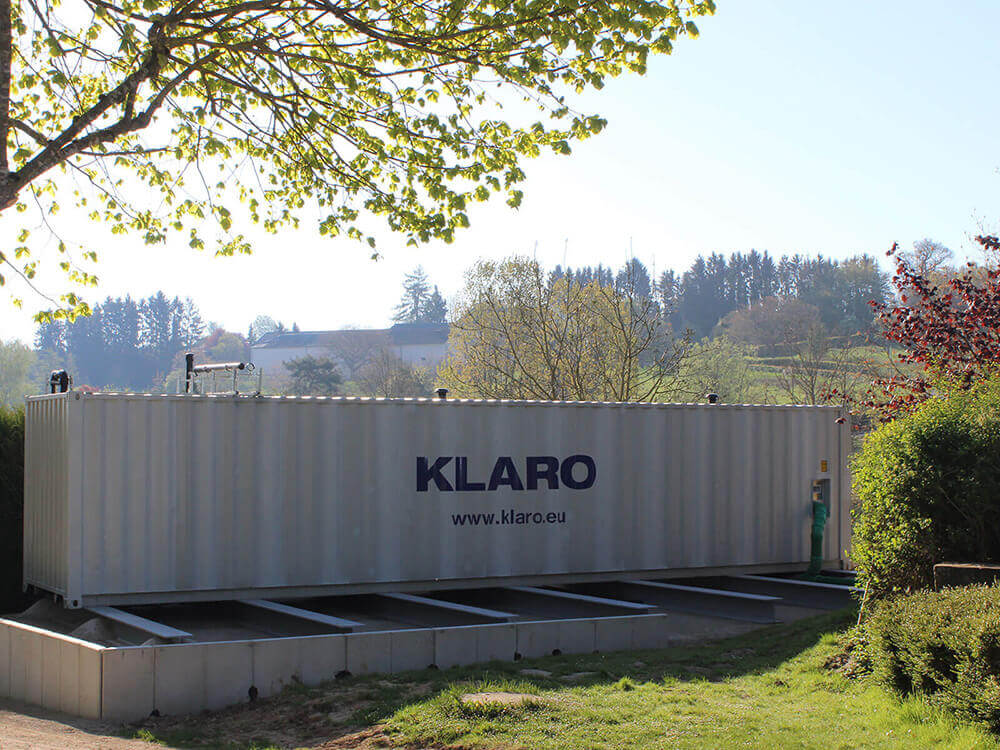
Areas of application for containerised wastewater treatment plants

Refugee camp
The challenges in refugee camps are very great - also and especially when it comes to wastewater treatment. In most cases, refugee camps are set up very quickly and out of nowhere; such crisis situations are rarely planned. In the process, improvised tent cities are created on undeveloped and undeveloped land, without infrastructure and without sanitation facilities.
In disaster situations, the removal and treatment of faeces often takes a back seat. Temporary latrines or toilet facilities are set up, which are far from optimal: Surface water and drinking water become contaminated, and the simple facilities without wastewater treatment and disinfection encourage the spread of diseases. The use of mobile container sewage treatment plants protects the people in the refugee camps.
Our containerised treatment plants are available within a few weeks. Thanks to the modular construction and pre-assembly in the factory, they can be easily set up and put into operation - a level, dry surface is sufficient to set up the plant.
The operation of the mobile wastewater treatment plants is simple, so that even the helpers on site are able to look after the plants after a short training. Most of the processes run fully automatically.
Quickly available, quickly set up, easy to operate - thus perfectly suited for this field of application.
Military camps
Especially during foreign deployments, camps of various sizes are created for the military, which are usually expanded over time. German regulations also require efficient wastewater treatment abroad. Thanks to the modular design of KLARO's container wastewater treatment plants, each wastewater system can be expanded or even supplemented as needed if stricter hygiene regulations come into force.
Another challenge in military camps are the safety requirements that also apply to the installed wastewater systems. Therefore, we provide the operator with complete documentation listing all system components and their functions for compliance with regulations.
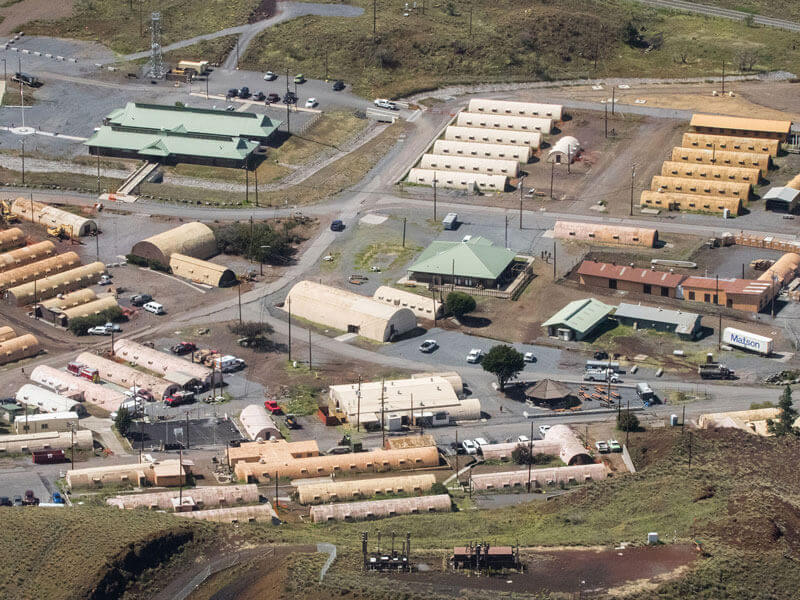
Worker and research camps
Whether in a mining workers' camp or a research camp in the jungle: where many people are working and there is no infrastructure in the form of sewage systems, mobile and uncomplicated solutions are an optimal substitute - like our container sewage treatment plants. Thanks to their compact size, they can be delivered to almost any place in the world. All that is required for installation is dry, level ground; in most cases, a foundation is not necessary.
Our containerised wastewater treatment plants can be delivered quickly and are easy to operate, so that the staff on site can look after them themselves after a short briefing. They are pre-assembled at the factory so that final assembly on site is quick and uncomplicated.
Thanks to their high quality, the technology and other components of the plant can withstand even extreme conditions, such as high temperatures or high humidity.
Containerised wastewater treatment plants installed at higher altitudes with lower atmospheric pressure are adapted to the climatic conditions so that there is sufficient oxygen available for the bacteria to grow and clean the wastewater.
Construction sites
Our containerised wastewater treatment plants are not only installed abroad in hard-to-reach places, but also offer the perfect solution in this country for short-term treatment of wastewater that is needed for a limited period of time. A typical site is a large construction site where many people work for months or years and where there is not yet a connection to the sewer system.
Here, the wastewater can be treated to such an extent that it can seep underground or flow into a receiving water body nearby.
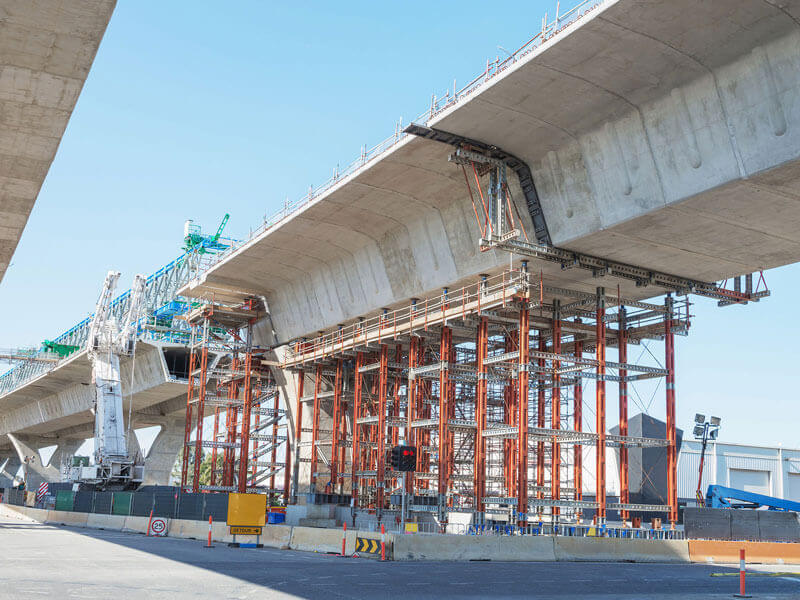

Municipalities
Municipalities like to use containerised wastewater treatment plants during conversion work on the existing sewage system or use the flexible systems as a permanent solution. Since our mobile wastewater treatment plants can be connected to each other, we can offer solutions for up to 1,300 residents, from the Container.One system to the large Container.Pro solution.
Seasonal tourism/camping
Short-term or particularly flexible solutions for the treatment of wastewater and faeces are also needed in other sectors. Examples here are campsites or tourist hotspots in hard-to-reach places that are only operated seasonally and do not necessarily require a connection to the sewage system. Here, too, temporary toilets can of course be set up. However, a professional sewage treatment plant offers visitors and operators more comfort and safety while maintaining the highest hygienic standards. The only prerequisite for the installation of a container sewage treatment plant is always a level and dry surface on which the plant can be set up.
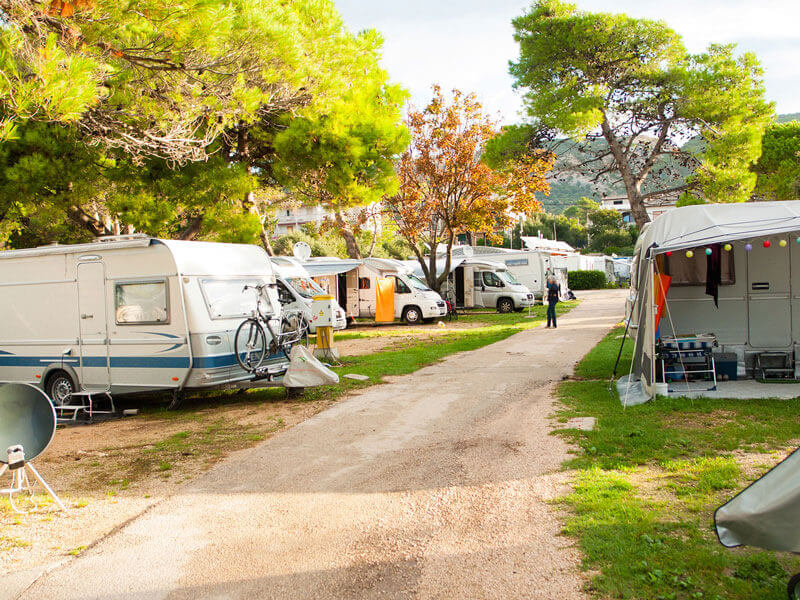
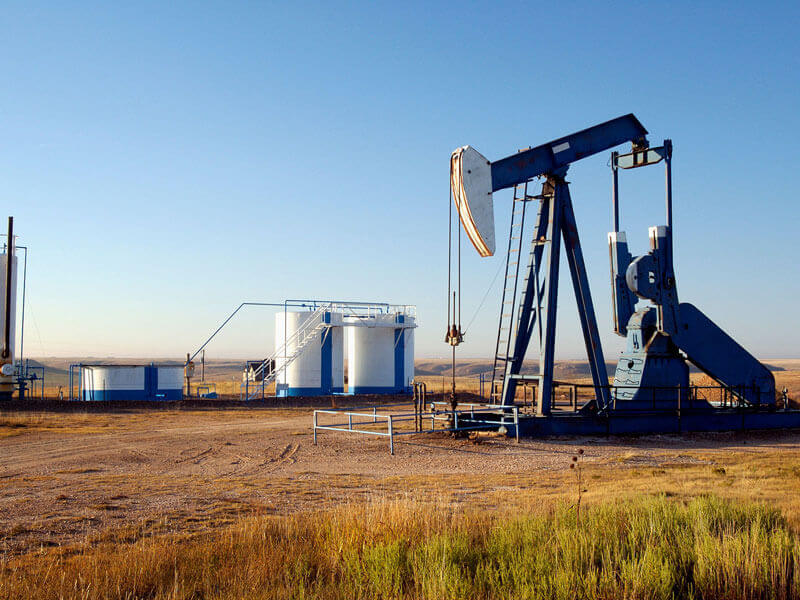
Oil and gas industry
In gas and oil fields, the number of employees varies greatly, depending on the production in the respective region, and thus the amount of wastewater also varies. At the same time, wastewater treatment has to comply with strict oil company regulations that focus on environmental protection. Since the oil and gas industry usually operates in remote locations without a sewer connection and, in addition, the location is often changed, wastewater treatment can become a challenge.
Our containerised wastewater treatment plants are optimal solutions for these requirements. We plan and install them according to the wastewater and its contents as well as the desired degree of purification. If necessary, the mobile container wastewater treatment plants can be easily expanded, reduced or set up at a different location.

